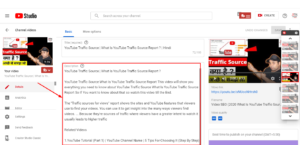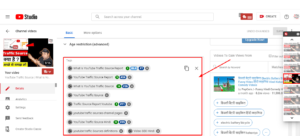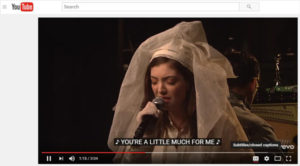In This Post, I Will Give You Top 10 Tips To Optimize Your Video On YouTube And Rank Your Video Number 1 On YouTube.
10 Tips to Optimize Your YouTube Video
- Rename your video Raw file Name using a target keyword.
- Insert Targeted keyword in the video title
- Optimize your video description
- Tag your video with popular keywords that relate to your Niche
- Categorize your video.
- Make an eye-catching thumbnail
- add subtitles & closed captions.
- Add Cards and End Screens to increase your YouTube channel’s viewership.
- Share on social media
- Embed Your Videos in Blog Posts
1. Rename your video Raw file Name using a target keyword.
Just like you would when optimizing the written content, you’ll use an SEO tool to first identify keywords you’d like your video to focus on (you can browse popular YouTube SEO tools below these tips, or just click that link earlier in this sentence).
With a keyword identified, the first place you should put it is your video Raw file — before you even upload it to YouTube. Why? YouTube can’t actually “watch” your video to see how relevant it is to your target keyword, and as you’ll learn in the tips below, there are only so many places you can safely insert this keyword on your video’s viewing page once it’s published. But, YouTube can read your video’s file name and all the code that comes with it when it’s uploaded.
With that in mind, replace the “YouTube SEO.Mp4″ file name (don’t be embarrassed … we’ve all been there during post-production) with your desired keyword. If your keyword is “house painting tips,” for example, your video’s file name should be “house-painting-tips” followed by your preferred video file type (MOV, MP4, and WMV are some of the most common that are compatible with YouTube).

2. Insert Targeted keyword in the video title
Do you know how you always optimize your headlines for written content? The same goes for YouTube.You want to include your focus keyword in your video title, and you should also solve a problem with your title. When you read Hemant4You video title, you immediately know what benefits you’ll get:

You should be that clear with your own titles.
3. Optimize your video description
First things first: According to Google, the official character limit for YouTube video descriptions is 1,000 characters. And while it’s okay to use all of that space, remember that your viewer most likely came here to watch a video, not to read an essay.
If you do choose to write a longer description, keep in mind that YouTube only displays the first two or three lines of text — that amounts to about 100 characters. After that point, viewers have to click “show more” to see the full description. That’s why we suggest front-loading the description with the most important information, like CTAs or crucial links.
As for optimizing the video itself, it doesn’t hurt to add a transcript of the video, especially for those who have to watch it without volume. That said, Backlinko’s research also found no correlation between descriptions that were optimized for a certain keyword and the rankings for that term.

Dean is careful not to encourage ditching an optimized description altogether, though. “An optimized description helps you show up in the suggested videos sidebar,” he writes, “which is a significant source of views for most channels.”
4. Tag your video with popular keywords that relate to your Niche
YouTube’s official Creator Academy suggests using tags to let viewers know what your video is about. But you’re not just informing your viewers — you’re also informing YouTube itself. Dean explains that the platform uses tags “to understand the content and context of your video.”
That way, YouTube figures out how to associate your video with similar videos, which can broaden your content’s reach. But choose your tags wisely. Don’t use an irrelevant tag because you think it’ll get you more views — in fact, Google might penalize you for that. And similar to your description, lead with the most important keywords, including a good mix of those that are common and more long-tail (as in, those that answer a question like “how to do I?”).

5. Categorize your video.
Once you upload a video, you can categorize it under “Advanced settings.” Choosing a category is another way to group your video with similar content on YouTube so it winds up in different playlists and gains exposure to more viewers who identify with your audience.
It might not be as simple as it looks. In fact, YouTube’s Creator Academy suggests marketers go through a comprehensive process to determine which category each video belongs in. It’s helpful, the guide writes, “to think about what is working well for each category” you’re considering by answering questions like:
- Who are the top creators within the category? What are they known for and what do they do well?
- Are there any patterns between the audiences of similar channels within a given category?
- Do the videos within a similar category have share qualities like production value, length, or format?

6. Make an eye-catching thumbnail
Your video thumbnail isn’t a ranking factor that YouTube uses directly, but it still has a huge impact on your SEO.
A good thumbnail means more clicks, and that means better SEO.
Make sure your thumbnail stands out and tells viewers what your video is all about.
Many people will view videos just from looking at the thumbnails, so don’t skip this step.

7. Add subtitles & closed captions.
Here’s a cool YouTube SEO hack that will give you a big edge. You might know that YouTube videos support closed captions.

When you toggle this option, the captions appear: These are meant for people who are deaf or hard of hearing, but they have an unexpected SEO benefit.
Closed captions are crawlable by search engines! That means you’ll get a nice SEO boost if you enable closed captions.
YouTube does support automatic captioning, but it’s not perfect. You can edit those captions, or you can add your own. Whatever you do, make sure the captions are accurate.
8. Add Cards and End Screens to increase your YouTube channel’s viewership.

Cards
When you’re watching a video, have you ever seen a small white, circular icon with an “i” in the center appear in the corner, or a translucent bar of text asking you to subscribe? Those are Cards, which Creator Academy describes as “preformatted notifications that appear on desktop and mobile which you can set up to promote your brand and other videos on your channel.”
You can add up to five cards to a single video, and there are six types:
- Channel cards that direct viewers to another channel.
- Donation cards to encourage fundraising on behalf of U.S. nonprofit organizations.
- Fan funding to ask your viewers to help support the creation of your video content.
- Link cards, which direct viewers to an external site, approved crowdfunding platform, or an approved merchandise selling platform.
- Poll cards, which pose a question to viewers and allow them to vote for a response.
- Video or playlist cards, which link to other YouTube content of this kind.
For detailed steps on adding a card to your video, follow these official steps from Google, or check out the video below.
End Screens
An End Screen (also referred to as an “End Card” or “Endslate”) is a YouTube feature that appears in the last 5-20 seconds of a video. YouTubers can use their end screen to promote videos, playlists, merchandise and external websites. … They can watch another video in the Suggested Video sidebar.
9. Share on social media
Here, the concept is simple, and probably a bit obvious.But it’s an important point.
Today’s web is social. YouTube is a social channel. And to maximize YouTube visibility and SEO, you need to share your videos on every social channel available
- Share on Facebook
- Share on Twitter
- Share on LinkedIn
- Share on Quora
10. Embed Your Videos in Blog Posts
Embedding your videos has two purposes.
First, it gets your video in front of more people. You can embed your video anywhere, but I recommend blog posts.
Second, it will increase your user engagement. This is a direct result of getting more people to watch your video.
Also Check- YouTube SEO (2020) | How to Rank #1 On YouTube (Hindi)
